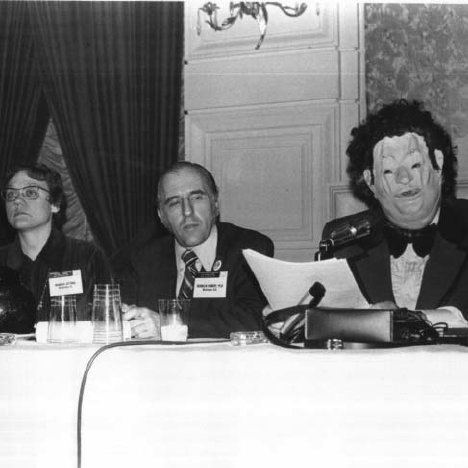DR. JOHN FRYER APPEARS BEFORE THE AMERICAN PSYCHUIATRIC ASSOCIATION
Introduced to the room as Dr. Henry Anonymous, wearing a wig and a tuxedo three sizes too big, and speaking through a microphone that distorted his voice, Dr. John Fryer stood in front of a crowd of psychiatrists at their annual meeting donning a garish Richard M. Nixon mask he and his lover had modified.
Removing the classification of homosexuality as a mental illness had been a mission of gay activists since at least the mid-1960s. Homosexuality was first classified as a disorder in 1952, when the first edition of the Diagnostic and Statistical Manual of Mental Disorders (commonly known as the DSM, the bible of the psychiatric field and the book from which all diagnoses are recognized) was published. The classification meant people could be institutionalized against their will, fired from their job, denied a mortgage or have their rights otherwise limited. Homosexual desire was considered an affliction, and acceptable “cures” included treatments like chemical castration, electroconvulsive therapy and lobotomy.
His declaration changed the world: “I am a homosexual. I am a psychiatrist.”
At the time of his speaking, Fryer was on the faculty of Temple University, but did not have the security of tenure, so he was in real danger of losing his position if he had been identified – he had already lost a residency at the University of Pennsylvania, and was later forced to leave a position on the staff of Friends Hospital because of his flamboyance. According to Fryer, he found it to be ironic that the Friends administrator who had told him, “If you were gay and not flamboyant, we would keep you. If you were flamboyant and not gay we would keep you. But since you are both gay and flamboyant, we cannot keep you” was in the front row at his 1972 appearance as Dr. Anonymous and never realized that “Anonymous” was Fryer.
At least one other panelist agreed with Fryer and Kameny that the stance of the psychiatric establishment toward homosexuality was wrong. The vice president of the APA at the time and later president, Dr. Judd Marmor, said: “I must concede that psychiatry is prejudiced as has been charged. Psychiatric mores reflect the predominant social mores of the culture.” He later wrote: “In a democratic society we recognize the rights of such individuals to have widely divergent religious preferences, as long as they do not attempt to force their beliefs on others who do not share them. Our attitudes toward divergent sexual preferences, however, are quite different, obviously because moral values – couched in ‘medical’ and ‘scientific’ rationalizations – are involved.”
Homosexuality was removed from the Diagnostic and Statistical Manual in 1973, a year after Fryer’s speech – leading the now-defunct Philadelphia Bulletin to print the headline “Homosexuals gain instant cure” – and Fryer’s speech has been cited as a key factor in persuading the psychiatric community to reach this decision. Gittings later said of it: “His speech shook up psychiatry. He was the right person at the right time.” Fryer later wrote in a 1985 newsletter of the Association of Gay and Lesbian Psychiatrists, that it was “something that had to be done” and “the central event in my career… I had been thrown out of a residency because I was gay. I lost a job because I was gay… It had to be said, but I couldn’t do it as me… I was not yet full time on the [Temple] faculty. I am now tenured, and tenured by a chairman who knows I’m gay. That’s how things have changed.”
